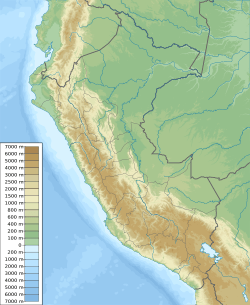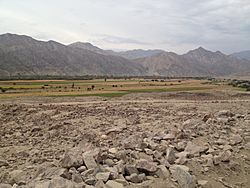Pernil Alto facts for kids
| Location | Ica Region, Peru |
|---|---|
| Coordinates | 14°29′38″S 75°12′36″W / 14.494°S 75.21°W |
| Type | ruins |
| History | |
| Founded | c. 3800 BCE |
| Abandoned | c. 3000 BCE |
The Pernil Alto archaeological site is a very old place where people used to live. It is found in the Ica Region of Peru. Archaeologists study old sites like this to learn about the past.
People lived at Pernil Alto a long, long time ago. They started farming there between 3800 BCE and 3000 BCE. This means they began growing their own food. Scientists used radiocarbon dating to find out these dates. This method helps them figure out how old things are.
Pernil Alto is special because it's the oldest known farming village far from the coast in the Central Andes. The Andes are a huge mountain range in South America. By 3300 BCE, farming had become the main way people got their food at Pernil Alto.
Contents
Discovering Pernil Alto
Pernil Alto was found in 2001 by a group called the German Archaeological Institute. It is located in the foothills of the Andes mountains. This site is about 60 kilometers (37 miles) from the Pacific Ocean. It is also about 50 kilometers (31 miles) from the high Andes mountains.
The village sits on a raised area, like a natural platform. This platform is about 10 meters (33 feet) above the Rio Grande de Nazca River valley. The site is about 400 meters (1,312 feet) above sea level.
Pernil Alto's Ancient Environment
Today, the area around Pernil Alto is a desert. It gets very little rain, less than 1 inch (25 mm) each year. But 5,000 years ago, it was different. The climate was better for plants and animals. It probably rained about 200 mm (8 inches) each year. There were grasslands and forests near the river. This made it a good place for people to live. They could farm, hunt, and gather wild foods.
Life in the Village
Archaeologists have explored about 1,200 square meters (13,000 sq ft) of the site. They found 18 homes there. These homes were not all used at the same time. They were small, round or oval huts built partly underground. Each hut was about 2.5 to 3 meters (8 to 10 feet) wide. They also had fireplaces and places to store food.
What Archaeologists Found
Scientists found 33 graves at Pernil Alto, with the skeletons of 35 people. They also found many tools and items. These were made from stone, bone, wood, and straw. Some jewelry was also found.
The village was likely home to about 50 people at its busiest time. The way the homes were set up, around an open area, shows it was a settled village. People lived there all year. This is different from hunter-gatherers who move around a lot.
How Farming Began
The dry climate at Pernil Alto helped keep ancient plant remains safe. This allowed archaeologists to study what people ate. They learned how farming slowly became the main way people got food.
Plants People Grew
Scientists found remains of ten types of edible plants. The most important wild food was a type of mesquite tree. It produced beans and pods that people could eat.
The main crops people grew were sweet potatoes and lima beans. Other plants they farmed included:
- Canna (an edible root)
- Beans
- Guava (a fruit)
- Jack-beans
- Squash
- Jicama (another edible root)
People also grew bottle gourds. These were not for eating but for making containers. Interestingly, two very common foods in later Peruvian history, maize (corn) and potatoes, were not found here. The plants grown at Pernil Alto did not start there. They were brought in from other farming groups.
From Wild Foods to Farmed Foods
Archaeologists studied the plant remains to see how diets changed.
- Around 3800 BCE, more than 60% of the food came from wild plants.
- By 3000 BCE, over 70% of the food came from cultivated (farmed) plants.
- Around 3300 BCE, the amount of wild food and farmed food was about equal.
This shows that over about 800 years, Pernil Alto changed a lot. It went from a small camp of hunter-gatherers who did a little farming to a village of farmers who grew most of their food.
Why the Village Was Left
The village of Pernil Alto was abandoned around 2900 BCE. One idea is that the Rio Grande River changed its path. If the river moved too far away, it would have been hard to get water for farming and daily life.
Archaeologists believe Pernil Alto is the oldest known agricultural village in the Central Andes. However, they also think that other similar old villages might still be found in the Andes foothills. There were also older villages near the Pacific coast of Peru. But those villages relied more on food from the ocean than on farming.



